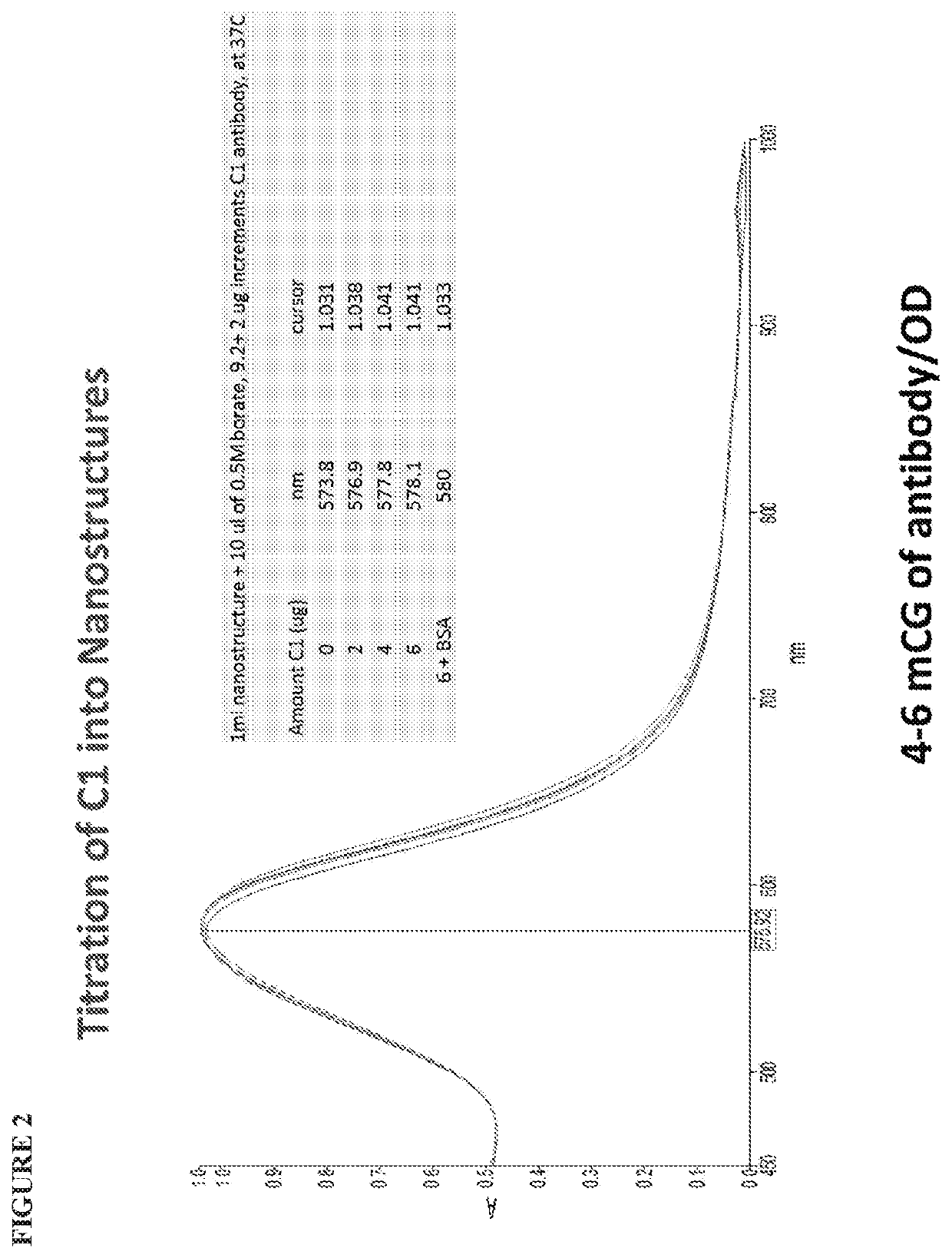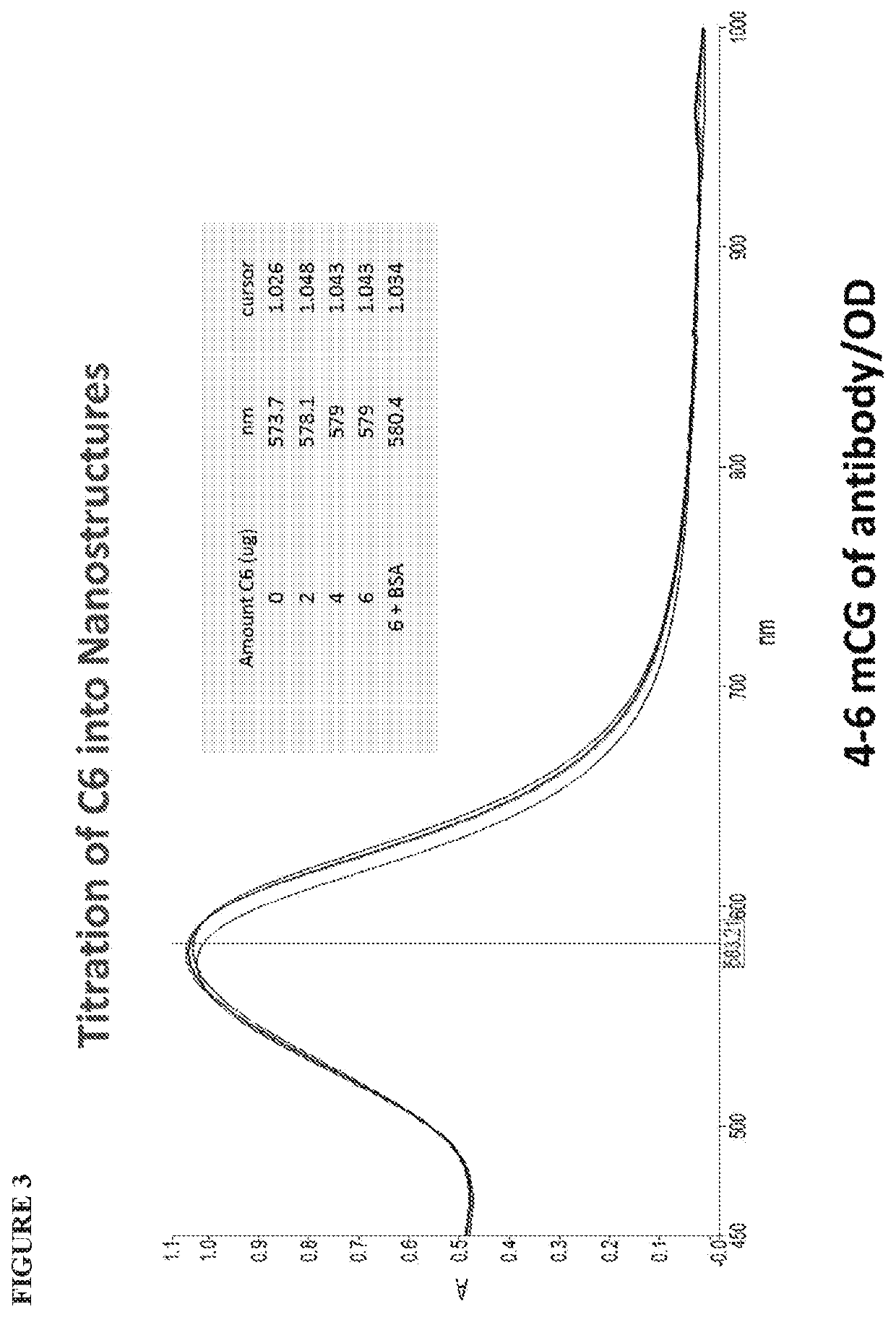Solution-based plasmonic specific-binding partner assays using metallic nanostructures
a specific-binding partner and metallic nanostructure technology, applied in the field of target analyte detection systems, can solve the problems of low sensitivity of assays, inability to quantitatively monitor the kinetics of sequential binding events, and inability to achieve high-sensitivity assays, so as to minimize the level of non-specific binding
- Summary
- Abstract
- Description
- Claims
- Application Information
AI Technical Summary
Benefits of technology
Problems solved by technology
Method used
Image
Examples
example 1
of Antibody Clones for Conjugation to Nanostructures
[0113]Studies were conducted to identify a protocol for conjugating nanostructures having a plurality of spikes to exemplary antibodies. First, titration experiments were conducted to titrate anti-TSH clone C1 into the nanostructures in order to determine the antibody quantity required for optimal conjugation.
[0114]The reaction was setup in a 1 ml cuvette placed in Lambda950 spectrophotometer. One ml of the nanostructures was placed into the cuvette after pH adjustment to 9.2 with 10 microliters of 0.5M borate, pH 9.2. The spectrum was recorded which showed λmax at 573.8 nm. The binding of antibody C1 was determined by observing peak shift upon successive additions of 2 μg of the antibody. The equivalence point was reached at about 6-8 microgram antibody per OD unit. Finally 10 microliters of 20% BSA was added to block nonspecific binding events. This resulted in an additional 2 nm shift in λmax. The results are provided in FIG. 2....
example 2
on of Nanostructures to Antibodies Via Adsorptive Conjugation Protocol
[0118]To generate nanostructure conjugates, nanostructures having a plurality of protrusions and an average diameter of 50 nm (lamdamax at 575 nm-1.0 OD / mL) were adjusted to pH 8.8 with 0.1M borate. C1 or C6 antibodies (about 33 picomoles per OD nanostructure) were titrated in and mixed well for 15 minutes. 2 mg BSA per ml was added and mixed for a further 15 minutes. Nanostructure / C1 or / C6 mixtures were centrifuged for 15,000 g for 10 minutes; supernatant was removed; and the conjugates were resuspended in conjugate diluent CG-1P, comprising PBS / BSA and CHAPS. CHAPS was particularly important to the resuspension of C6 antibodies, which are hydrophobic. Moreover, the CHAPS detergent helped prevent nonspecific size / shape changes leading to aggregation.
[0119]FIG. 6 shows the spectral shifts, for conjugates generated using the adsorptive protocol, of (i) 50 nm nanostructures prior to conjugation; (ii) 50 nm nanostru...
example 3
on of Nanostructures to Antibodies Via Thiol-Mediated Conjugation Protocol
[0121]To generate nanostructure conjugates using the thiol-mediated conjugation protocol, nanostructures having a plurality of protrusions and an average diameter of 50 nm (λmax at 575 nm-1.0 OD / mL) were adjusted to pH 8.8 with 0.1M borate. TCEP-reduced C1 or C6 antibodies (about 33 picomoles per OD nanostructure) were titrated in and mixed well for 15 minutes. 2 mg BSA per ml was added and mixed for a further 15 minutes. Nanostructure / C1 or / C6 mixtures were centrifuged for 15,000 g for 10 minutes; supernatant was removed; and the conjugates were resuspended in conjugate diluent CG-1P, comprising PBS / BSA and CHAPS. CHAPS was particularly important to the resuspension of C6 antibodies, which are hydrophobic. Moreover, the CHAPS detergent helped prevent nonspecific size / shape changes leading to aggregation.
[0122]FIG. 8 shows the spectral shifts, for conjugates generated using the thiol-mediated conjugation prot...
PUM
| Property | Measurement | Unit |
|---|---|---|
| diameter | aaaaa | aaaaa |
| diameter | aaaaa | aaaaa |
| diameter | aaaaa | aaaaa |
Abstract
Description
Claims
Application Information
 Login to View More
Login to View More - R&D
- Intellectual Property
- Life Sciences
- Materials
- Tech Scout
- Unparalleled Data Quality
- Higher Quality Content
- 60% Fewer Hallucinations
Browse by: Latest US Patents, China's latest patents, Technical Efficacy Thesaurus, Application Domain, Technology Topic, Popular Technical Reports.
© 2025 PatSnap. All rights reserved.Legal|Privacy policy|Modern Slavery Act Transparency Statement|Sitemap|About US| Contact US: help@patsnap.com



